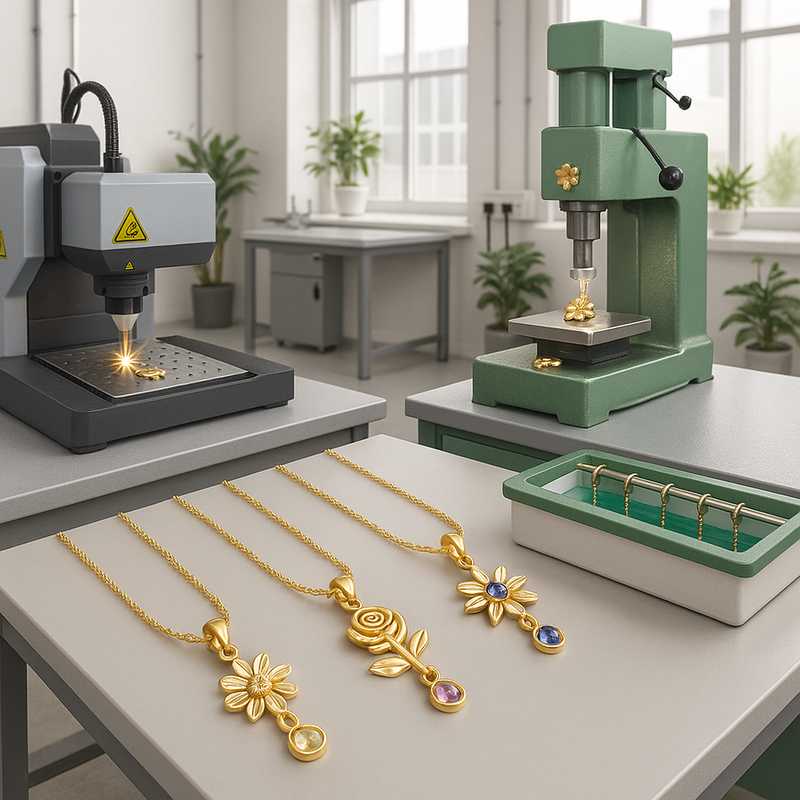Material Mastery: Precision & Sustainability in Gold Charm Jewelry

Explore how 304 vs 316L steel, laser tech, and green processes shape OEM charm necklace excellence
In the evolving world of custom jewelry manufacturing, the fusion of material science, advanced engineering, and sustainable innovation defines market leadership. Nowhere is this more evident than in the development of bespoke birth month flower and birthstone charm bouquet necklaces. For B2B clients seeking OEM/ODM stainless steel jewelry partners, understanding the nuances behind material selection and technology deployment is not merely academic—it’s a business imperative. This page explores how the careful comparison of 304 vs 316L stainless steel, combined with high-precision manufacturing methods such as laser cutting and hydraulic forming, and green processes like zero-waste recycling and eco-friendly plating, creates jewelry that is both exquisitely crafted and ethically produced.
Comparing 304 and 316L Stainless Steel: Material Behavior in Real-World Jewelry Use
While both 304 and 316L stainless steel are staples in the world of metal-based accessories, the choice between the two can drastically influence the final product’s durability, aesthetics, and customer satisfaction. For OEM gold charm necklaces, the application context often determines the optimal choice.
Corrosion Resistance
304 stainless steel is an affordable, versatile option, boasting excellent formability and oxidation resistance. However, in humid or saline environments—like coastal regions or during prolonged skin contact—304 may develop surface pitting or tarnish over time.
By contrast, 316L (the “L” denoting low carbon content) offers enhanced corrosion resistance, thanks to the inclusion of molybdenum. This makes 316L ideal for charm necklaces worn daily or gifted in tropical climates, offering greater longevity and skin-friendliness. For hypoallergenic claims, 316L outperforms due to reduced nickel migration.
Application Case Studies
- 304 Use Case: Seasonal promotional necklace lines with a limited wear lifecycle benefit from the affordability of 304. For example, a spring collection of flower charms sold through a fashion retailer may utilize 304 to balance budget and aesthetics.
- 316L Use Case: High-end personalized birthstone flower necklaces, intended as heirloom gifts or daily wear accessories, leverage 316L for its superior performance and premium appeal.
Precision Engineering in Jewelry: The Role of Laser and Hydraulic Technologies
The transition from design sketch to wearable charm involves precision at a microscopic level. Laser cutting and hydraulic press forming play pivotal roles in sculpting intricate floral patterns and gemstone bezels with industrial-grade accuracy.
Laser Cutting for Floral Petal Detailing
Modern fiber laser machines enable high-speed, low-burr cutting of stainless steel sheets, essential for fine-petaled birth month flowers. The beam’s intensity allows designers to replicate botanical features like serrated leaf edges and curved stamens without post-processing distortion.
One OEM case leveraged a 500W fiber laser to produce 0.5mm thick rose charms, achieving tolerance deviations of less than 0.02mm. The result: high-fidelity replicas of customer-submitted flower sketches in bulk production runs of over 10,000 units.
Hydraulic Press Forming for Bezel and Setting Integration
Hydraulic presses, calibrated for jewelry-grade operations, mold steel forms to house cubic zirconia or birthstones securely. Custom dies are machined in-house using CAD/CAM workflows, offering the flexibility to adapt quickly to trend-responsive design changes.
Combining press-forming with laser-cut overlays yields multi-layer charms—such as an engraved petal overlay seated above a gemstone bezel—highlighting both artisanal flair and engineered resilience.
Corrosion Patterning and Electro-Texturing: Beyond Function to Aesthetic Innovation
While corrosion resistance is often discussed in terms of durability, intentional micro-corrosion and electro-texturing have emerged as aesthetic design tools in charm jewelry production.
Electrochemical Etching Techniques
By using controlled acid-based electrochemical baths, manufacturers create corrosion-based patterning that mimics vintage textures or introduces matte contrast surfaces. Popular with minimalist designs, this technique enables nature-inspired finishes on birth flower motifs—think oxidized veins on a daisy petal or radial etching on a sunflower charm.
Case Study: Dual-Tone Rose Petal Finish
In a 2024 OEM campaign, a jewelry brand commissioned a dual-tone rose charm using selective etching and passivation. The result was a golden brushed outer petal (achieved through anodic masking) paired with a shiny central bud—achieving visual depth without paint or overlays, preserving hypoallergenic integrity.
Eco-Conscious Manufacturing: From Material Sourcing to Final Plating
Today’s B2B buyers prioritize not only product quality but also production ethics. Sustainable manufacturing has become a major differentiator in stainless steel jewelry OEM partnerships. Implementing green processes isn’t just eco-conscious—it’s commercially strategic.
Recycled Material Integration
Many forward-thinking factories now integrate up to 80% recycled stainless steel in their supply chains. By using closed-loop scrap collection systems, waste metal from cutting and forming is reprocessed into new sheet stock, reducing both cost and environmental impact.
Eco-Friendly Electroplating
Traditional plating processes often involve cyanide-based solutions and high heavy metal discharge. Newer green plating methods use trivalent gold baths and non-toxic surfactants, coupled with multi-stage wastewater filtration systems to minimize effluent discharge. Charm necklaces now feature long-lasting PVD or vacuum plating finishes, dramatically extending colorfastness while staying RoHS-compliant.
Certifications and Transparency
Leading OEMs offer supply chain transparency, with certifications such as ISO 14001, REACH, and SGS compliance for their eco-practices. This gives B2B buyers a marketable sustainability edge, especially when marketing to environmentally aware consumers or luxury buyers.
Conclusion: The Material Difference That Defines Market Success
Material mastery and manufacturing integrity are not optional—they are the blueprint for success in custom gold charm necklace production. From the smart selection between 304 and 316L stainless steel to the implementation of laser technology, corrosion-based aesthetics, and green factory practices, OEM partners have the opportunity to deliver excellence that scales. For B2B customers seeking premium, sustainable, and beautifully engineered jewelry, the path forward is clear: align with manufacturers who value both precision and planet.
Ready to elevate your next birthstone charm collection with ethical excellence and technical mastery? Connect with our OEM experts today to begin your custom development journey.
